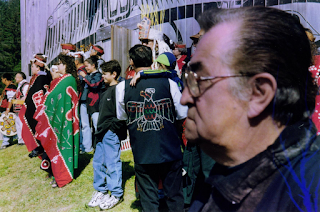 |
| RIP Marcus Alfred |
Thursday, November 29, 2012
Marcus Alfred, a monumental carver on the west coast of North America
Wednesday, June 1, 2011
Pat Alfred Memorial Potlatch
Pat Alfred's Memorial Potlatch took place mid-spring 2011 in Alert Bay, B.C., and the gathering came to the Big House of the Namgis Nation on Cormorant Island. The Alfred family was preparing the Potlatch for late April or May, and the Alfreds received a lot of community support. They gave a treasure of memories and gifts in return.
Tuesday, August 12, 2008
Beau Dick canoe carving project on Yukusem, aka Hanson Island, B.C.
 |
| Hawk Hawkins and Beau Dick, circa 2008, Yukusem Culture Bivouac on Hanson Island, B.C.. |
Beau Dick is a machine when it comes to working with wood. He is a Kwakwala carver of renowned ability whose life includes meeting the British Royal Family, and includes possession of the highest ranking bloodline.
Beau Dick was raised in Kingcome Inlet, B.C. (an obscure postal code), and grew up within a Big House society still standing in the splendour of its generations.
Kingcome Inlet represented a miraculous survival where traditionalists had dodged a lot of bullets, both literal and figurative, through many previous decades.
Beau Dick learned to carve from his grandfather and father and the teaching contained the deeper meaning of this unique form of artistic expression. He learned these important lessons at the archetype level, from which level was born a life-force.
With this knowledge and energy Beau Dick has launched himself into the community to show people the deeper meaning of their old ways.
The timing is right for Beau Dick. He found it easier to create a significant cultural revival since the return of Hanson Island to First Nation custody. It is an opportunity to break out of systematic oppression.
Proof of Aboriginal stewardship of this island has been uncovered in rich Hanson Island Old Growth cedar groves, because the Cultural Modified Trees are filled with archaeological evidence of Aboriginal Rights and Title.
Hanson Island has been returned to the custody of the First Nations. CMTs have restored once-hidden knowledge about shore-based societies constructed around rainforest cedar groves.
David Garrick, anthropologist, coined the term “transgenerational” management of forest resources to explain a social arrangement in forests. Rainforests were ‘managed’ under carefully defined jurisdiction.
Social groups practiced grand scale horticulture on stands of cedar on Yukusem’s (Hanson Island) 16 square kilometres. They made cedar trees do the most amazing things. Excess bark was produced for harvest, which might take a couple hundred years to get to.
Harry Alfred (et al) has taken scientific evidence to carve a role in management. He is one of the board of directors of Yukusem Heritage Society, which has custody of most of Hanson Island.
He is also, “land and resource officer of the Namgis First Nation,” he explained, one afternoon in a Garrick-constructed garden in Yukusem heights.
“The Namgis traditional territory,” said Alfred, comprised, “about 4,000 sq km.” Extending an arm to four corners he described a rectangular shaped territory with Yukusem almost centre.
Harry Alfred said the community rebounded due to David Garrick’s work in cedar groves on Yukusem (over 20 years of hands-on research). The First Nations managers have devoted nation-building energy to CMT research.
A hundred people been trained by Garrick and these are people who have regained cultural balance from the experience.
Life goes on, yes, and Beau Dick, a realist, knows this. He is adding something to a historically significant nation using the old secrets of majestic Indian Nation jurisdiction.
On the southwest quadrant of Yukusem he is staging a canoe carving project and building a cultural camp to teach people the old ways about sharing a forest in a transgenerational and environmentally sustainable way.
Monday, May 5, 2008
All-time Reader's Choice
-
I asked our friendly neighborhood Grok xAI: What is CBC Journalist Andrew Coyne's family relationship to Justin Trudeau and Mark Carne...
-
The estimates of economic ruin are inescapable Kris Eriksen, in Canada @KEriksenV2 says, "So, now can we ALL agree that Canadians are ...
-
Sounds positively giddy you can send 4.84 million barrels of crude oil per day to the United States but take a few bottles of bourbon in re...
-
Wait for the sign: an auspicious portent last year over a planting camp near Burns Lake. 2025, so far, is going well, according to field rep...
-
So I'll be a monkey's uncle. The Liberal Crime Syndicate just robbed Canadian residents of three-quarters of a trillion dollars i...
-
The federal Liberal Party running a lottery on Canadians feels like the new game in town. It's not the usual lottery. The Liberal Lo...
-
pic.twitter.com/u6ZFHSWMri — Vote Canada (@VoteCanadaCom) June 5, 2025













